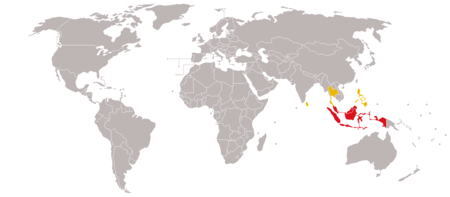
Back جهان مالایی Persian Malaijialue Finnish Monde malais French העולם המלאי HE Dunia Melayu ID Tontolo Maley Malagasy Alam Malayu MIN Alam Melayu Malay Малайский мир Russian 马来世界 Chinese

The Malay world or Malay realm (Indonesian/Malay: Dunia Melayu or Alam Melayu) is a concept or an expression that has been used by different authors and groups over time to denote several different notions, derived from varied interpretations of 'Malay' either as an ethnic group, as a racial category, as a linguistic group or as a cultural group. The use of the term Malay in much of the conceptualisation is largely based on the prevalent Malay cultural influence, manifested in particular through the spread of the Malay language in Southeast Asia as observed by different colonial powers during the Age of Discovery and spread of Islam.[1] The term remains highly controversial in Indonesia and outside the Malay-speaking areas, because it is considered politically charged and irredentist rather than purely cultural.
The concept in its broadest territorial stretch may apply to a region synonymous with Austronesia, homeland to the Austronesian peoples, that extends from Easter Island in the east to Madagascar in the west.[2] Such description has its origin in the introduction of the term Malay race in the late 18th century that has been popularised by orientalists to describe the Austronesian peoples. In a narrower sense, the Malay world has been used as a synonym for Malay sprachraum, referring to the Malay-speaking countries and territories of Southeast Asia, where different standards of Malay are the national languages or a variety of it is an important minority language. The term in this sense encompasses Brunei, Indonesia, Malaysia, Singapore and Southern Thailand, and is sometimes used interchangeably with the concepts of 'Malay Archipelago' and 'Nusantara'.[3]
Malayophones (peoples and nations that speak Malay/Indonesian as their native language or recognize it as an official language) are projected to number an estimated 330 million people by 2025, comprising just under half of the population of Southeast Asia[4] in eight sovereign states and territories: Indonesia, Malaysia, Singapore and Brunei, where Malay is an official language under the name 'Malay', 'Indonesian' or 'Malaysian'; East Timor and parts of Thailand and the Philippines, where Malay/Indonesian is recognized as a minority or trade language, and the Australian territories of the Cocos (Keeling) Islands and Christmas Island, where Malay is the majority language and a significant minority, respectively.[5]
Alternatively, modern scholars correct these extended notions of the Malay world, defining it as a political and cultural area instead. In this context, the Malay world is reduced to a region that is homeland to the Malay ethnicity, historically ruled by rival sultanates, where various Malayic languages and cultural values are predominant. This area includes the coastal areas of the Malay Peninsula, Sumatra, Borneo, and the smaller islands in between.[6][7][8]
The most notable use of the concept was in the early 20th century, embraced in an irredentist fashion, by Malay nationalists in the form of 'Greater Indonesia' or 'Greater Malay' (Indonesia Raya/Melayu Raya), as an aspiration for the natural or desired borders of a modern nation for the Malay race. Classical works of Malay literature such as Sejarah Melayu and Hikayat Hang Tuah do not mention the term "Alam Melayu" (Malay world). The term only developed after 1930, with the first recorded examples coming from Majalah Guru, a Malay states monthly magazine, and the newspaper Saudara, which was published in Penang and circulated throughout the Straits Settlements. Alam Melayu as a concept was only developed and gained popularity after the emergence of Malay nationalism in the early 20th century.[9][10]
- ^ Ooi 2009, p. 181
- ^ Farrer 2009, p. 26
- ^ Amin Sweeney 2011, p. 295
- ^ https://www.populationpyramid.net [bare URL]
- ^ Samuel, J. (2010) Les voies de l’aménagement linguistique dans le monde malayophone, Télescope 16:3, 135–155.
- ^ Milner 1982, p. 112
- ^ Benjamin & Chou 2002, p. 7
- ^ Wee 1985, pp. 61–62
- ^ Roff 1974, p. 153
- ^ Roff 1974, pp. 212–221